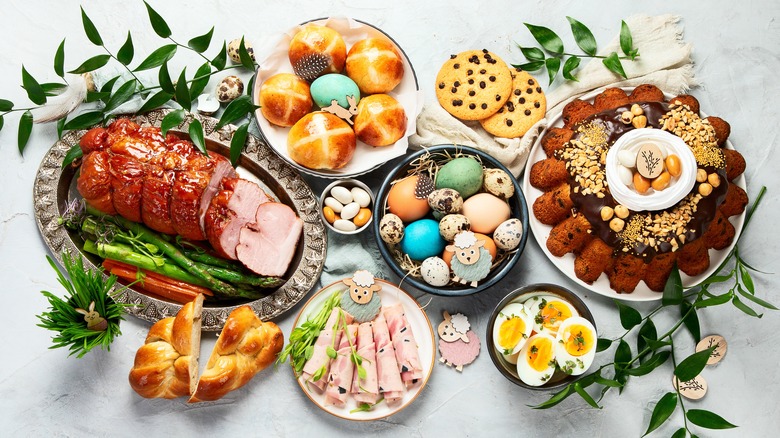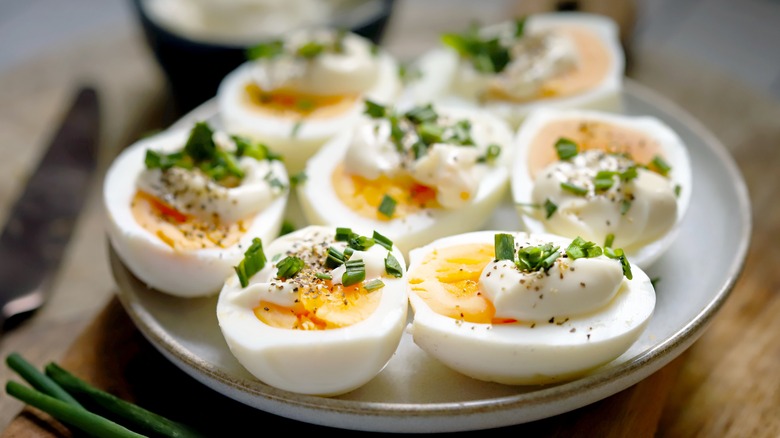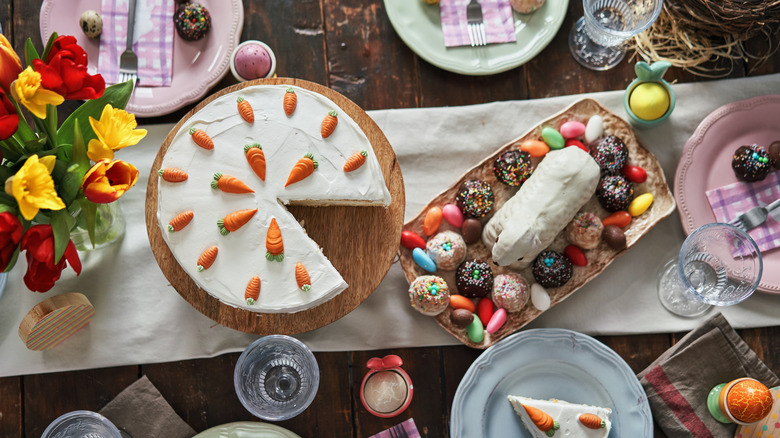What Does A Traditional Easter Dinner Usually Look Like In The US?
Some people serve a big roasted bird on Thanksgiving, while others subvert convention with all manner of turkey alternatives. Likewise, there's no hard and fast rule regarding what an Easter dinner in the U.S. should and should not include. Like its November counterpart, the spring holiday often features a showstopper of a main course accompanied by plenty of side dishes to sate both sweet and savory palates.
For meat eaters, that showstopper might be roasted lamb or baked ham. The former is more traditional for those who celebrate the holiday for its religious significance, as lamb often appears in the Old Testament as a sacrifice to God. Indeed, one can find the Pope dining on a spit-roasted lamb at the Vatican on Easter Sunday.
Meanwhile, secular dinner hosts are more likely to serve ham on Easter, which has been the case since the end of World War II when lamb proved far too expensive for the average American household. Ham can be served whole and honey-glazed on a platter for a nod to the 1950s cooking style from which it came, or it can be dressed down, sliced thin, and used for low-key ham sandwiches.
On the side
Another similarity between Thanksgiving and Easter dinners is that the sides are arguably the best part of the meal. The most satisfying holiday spreads are bound to include at least one mouthwatering starch, which might take the form of cheesy potato gratin, mashed potatoes, or a pasta bake.
Eggs, a symbol of new life, are another common fixture of U.S. Easter fare. If they're not being painted for an Easter egg hunt, they're getting hard-boiled, sliced, and fashioned into a plate of classic deviled eggs. The creamy finger food might be served as an appetizer if not featured on the dinner table.
Of course, no Easter dinner would be complete without vegetables. Since it takes place in the spring, seasonal produce like green beans, asparagus, and peas are typical. Vegetarians might even choose to add them to a savory galette or quiche as a main course. Finally, there's always room for flaky buttermilk biscuits or buttered rolls.
Don't forget dessert
If there's one Easter food group that doesn't need an introduction, it's dessert. From hollow chocolate bunnies to Cadbury eggs and Peeps, there's no shortage of processed sweets with which to fill an Easter basket.
Homemade confections, however, are just as much a part of the American Easter tradition as the denizens of a seasonal candy aisle. To our knowledge, only one of them has its own Mother Goose nursery rhyme: hot cross buns, an Easter tradition marked by yeasty, ever-so-sweet dough, a scored cross pattern, a coating of shiny icing, and, occasionally, a smattering of raisins and other dried fruit. A cup of coffee or tea is a pleasant way to cap off an Easter meal without risking a sugar crash.
Those averse to raisins might opt for a crowd-pleasing dessert that's decidedly better than chocolate bunnies, such as brownies, cheesecake, or a simple sheet cake. When the feast is complete and the dishes are put away, taking home Tupperware full of leftovers — including plenty of pastel-hued hard-boiled eggs — will keep the holiday going for days.


